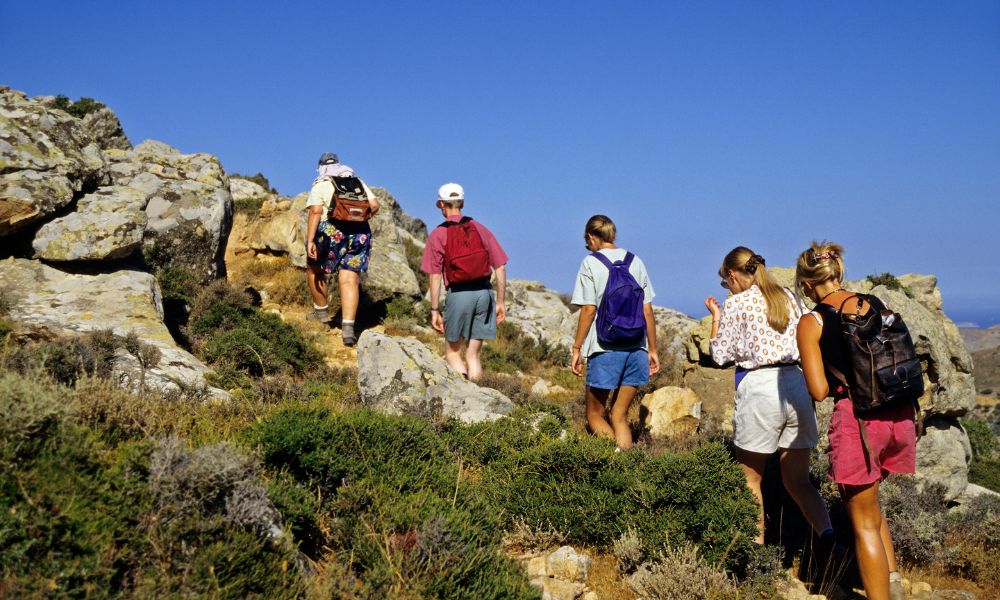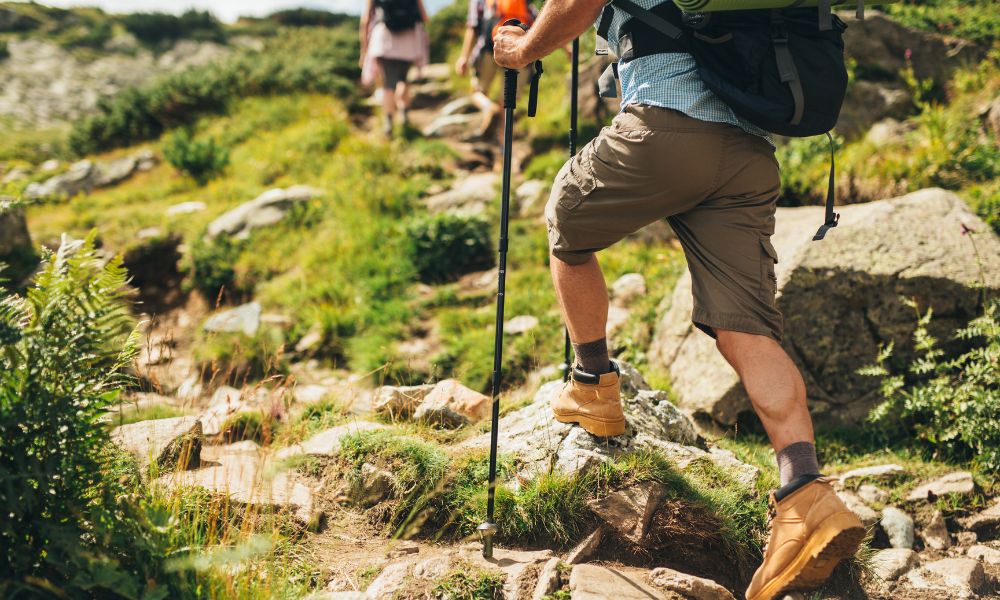Активный отдых на природе 一 это отличный способ перезагрузиться, укрепить здоровье и насладиться красотой окружающего мира. Но когда дело доходит до выбора конкретного вида активности, многие сталкиваются с вопросом: что лучше 一 хайкинг, треккинг или бэкпекинг? В этой статье мы подробно рассмотрим каждый из этих вариантов, их особенности, преимущества и недостатки, чтобы помочь вам сделать осознанный выбор для вашего следующего приключения. Но учтите, что вам может понадобится бронирование отелей в путешествии.
Хайкинг
Хайкинг — прекрасный способ провести время на природе, наслаждаясь живописными видами, свежим воздухом и легкой физической активностью без сложных испытаний. Для таких прогулок отлично подходят размеченные маршруты в национальных парках, лесопарках и горах. Главное — выбирать путь, соответствующий вашему уровню подготовки. Многие компании предлагают групповые туры для хайкинга, что делает этот вид отдыха еще более доступным. Чтобы хайкинг был комфортным и безопасным, важно правильно подобрать экипировку: удобная обувь, подходящая для пересеченной местности, одежда по погоде, а также рюкзак с водой, перекусом и аптечкой
Треккинг
Треккинг — это более сложное и требовательное испытание по сравнению с хайкингом. Он требует хорошей физической подготовки, обширного снаряжения и навыков ориентирования в природных условиях. В отличие от хайкинга, горный треккинг — это многодневное путешествие, включающее ночевки в палатках или приютах, а также перенос более тяжелого рюкзака с необходимым оборудованием.
Среди самых популярных маршрутов для хайкинга и треккинга в горах можно выделить восхождения на вершины, переходы через перевалы и походы по живописным долинам. Многие организованные группы выбирают именно такие маршруты, а для удобства участников часто предоставляется трансфер для групп, что позволяет комфортно добраться до начальной точки похода.
Бэкпекинг
Бэкпекинг — это наиболее автономный вид активного отдыха на природе, требующий полной готовности к любым условиям. Чтобы подготовиться к путешествию, важно заранее продумать маршрут, составить список необходимого снаряжения и потренироваться в ходьбе с тяжелым рюкзаком. Безопасность в бэкпекинге играет решающую роль, поэтому необходимо всегда иметь при себе карту и компас, владеть основами первой помощи и уметь разжигать костер.

Подборка снаряжения
Для успешного похода важно тщательно подойти к выбору снаряжения, учитывая тип маршрута и погодные условия.
Для хайкинга потребуется удобная обувь с хорошей амортизацией и нескользящей подошвой, одежда по погоде (слоистый принцип поможет регулировать теплообмен), а также небольшой рюкзак с запасами воды, легким перекусом и аптечкой.
При подготовке к треккингу стоит дополнительно учесть многодневные походы, а значит, потребуется палатка, спальник с подходящей температурой, кухонное оборудование (горелка, котелок, посуда), запас еды с высоким содержанием энергии и средство для фильтрации воды. Также важно взять карту, компас или GPS-устройство, дождевик, запасные носки и утепляющий слой одежды.
В бэкпекинг ключевым фактором является снижение веса рюкзака. Поэтому стоит выбирать ультралегкие модели палаток, спальных мешков и ковриков, компактную одежду из технологичных материалов, а также минималистичное кухонное оборудование.
Оптимальный набор включает фильтр для воды (механический или химический), еду с высокой калорийностью и длительным сроком хранения (сублимированные продукты, орехи, сухофрукты), многофункциональный нож, аптечку с расширенным комплектом первой помощи, налобный фонарь и запасные батарейки. Важно также продумать систему навигации и средства связи, особенно если маршрут проходит в отдаленных местах.

Советы по безопасности
Безопасность во время хайкинга, треккинга и бэкпэкинга 一 это фундамент успешного и приятного путешествия. Запомните, что природа может быть непредсказуемой, поэтому планирование и подготовка играют ключевую роль. Всегда сообщайте кому-то о своем маршруте, предполагаемом времени возвращения и контрольных точках. Это позволит своевременно организовать помощь в случае непредвиденных обстоятельств.Также можно использовать трекер GPS 一 по нему вас смогут в случае ЧП отследить быстрее.
Не пренебрегайте аптечкой, компасом, картой и надежным средством связи, ведь вдали от цивилизации они могут стать вашими лучшими друзьями. Изучите прогноз погоды перед выходом на маршрут и будьте готовы к изменениям. Помните о правилах поведения в дикой природе: не оставляйте мусор, не разводите костры в неположенных местах, уважайте диких животных и других туристов.
Особое внимание уделите выбору обуви и одежды, подходящей для условий вашего путешествия. Кроме того, если ваше приключение требует предварительного бронирования транспорта, стоит заранее позаботиться о подборе авиабилетов, чтобы комфортно добраться до начальной точки маршрута и избежать неожиданностей.
Эти советы для путешествий помогут вам получить удовольствие от похода. Помните, что безопасность 一 это не ограничение свободы, а возможность наслаждаться приключениями в полной мере.
Как выбрать подходящий маршрут?
Выбор маршрута для хайкинга, треккинга или бэкпэкинга требует внимательной подготовки, так как влияет на безопасность и комфорт путешествия. Прежде чем отправиться в поход, важно оценить свою физическую подготовку и навыки. Маршруты для хайкинга, как правило, простые и подходят для коротких прогулок по размеченным тропам, тогда как треккинг требует большей выносливости, поскольку предполагает многодневные походы с подъемами и спусками. Бэкпекинг требует полной автономности, навыков ориентирования и умения справляться с непредвиденными ситуациями.
Погодные условия также играют важную роль. Летние маршруты комфортны, но требуют защиты от солнца, осенние пейзажи завораживают, но дороги и тропы могут быть скользкими, зимой понадобится специальное снаряжение, а весной горные тропы иногда становятся просто непроходимыми. Перед выходом важно изучить прогноз и быть готовым к изменениям.
Особенности маршрута зависят от местности. Равнинные пути проще, горный треккинг сложнее и требует опыта, лесные тропы могут включать естественные препятствия, а переходы через водные преграды требуют дополнительного оборудования. Длина маршрута, точки отдыха и возможные места ночевки — все это необходимо продумать заранее.
Безопасность во время похода должна быть на первом месте. Важно заранее сообщить кому-то о планах и времени возвращения, взять GPS-трекер для отслеживания маршрута, карту, компас и аптечку. Логистика тоже играет роль, особенно если маршрут находится далеко от населенных пунктов. Стоит заранее продумать транспорт, подобрать удобный трансфер или забронировать авиабилеты.
Выбор маршрута — это баланс между личными возможностями, условиями окружающей среды и уровнем подготовки. Чем тщательнее будет планирование, тем приятнее и безопаснее окажется приключение.
Этикет на природе
Этикет на природе — это основа уважительного и ответственного поведения в окружающей среде. Независимо от того, путешествуете ли вы в одиночку или участвуете в групповых экскурсиях, важно соблюдать основные правила.
Во-первых, всегда оставляйте после себя чистое пространство. Не оставляйте мусор, утилизируйте отходы правильно и старайтесь минимизировать воздействие на природу. Во-вторых, не нарушайте естественную среду животных — не кормите их, не тревожьте их жилища и наблюдайте за ними на расстоянии.
При путешествии в группе следует уважать личное пространство и комфорт других участников. Держите умеренный уровень шума, особенно в местах с дикой природой. Во время групповых экскурсий важно следовать указаниям гида, не отходить от маршрута и поддерживать атмосферу взаимопомощи.
Соблюдение этих правил позволит сделать пребывание на природе приятным не только для вас, но и для других туристов, а также поможет сохранить окружающую среду для будущих поколений.
Перспективы и выгоды активного отдыха
Активный отдых на природе — это не только увлекательное путешествие, но и важный вклад в здоровье и общее самочувствие. Хайкинг, треккинг и бэкпекинг способствуют укреплению сердечно-сосудистой системы, повышению выносливости, улучшению настроения и снижению уровня стресса. Эти виды активности помогают обрести гармонию с природой, повысить самооценку и зарядиться энергией.
Независимо от того, какое направление вы выберете, оно подарит вам яркие эмоции и незабываемые впечатления. Кроме того, для удобства и комфортного путешествия можно заранее заказать групповую поездку, что позволит насладиться приключением в компании единомышленников, разделяющих вашу страсть к активному отдыху.








 ios
ios
 android
android




 Бел руб.
Бел руб.  Рос. рубль
Рос. рубль 



















